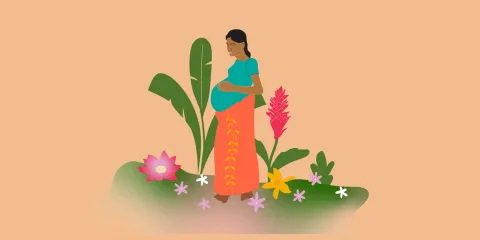Integrating maternal and child health and NCD services: Recipe for post-COVID recovery

In this blog, Dr Nimisha Goel (MBBS, MD), National Program Officer at the Norway India Partnership, explores maternal, newborn and child health in India in the context of post-COVID recovery by focussing on the burden of noncommunicable diseases (NCDs) in the country and advocating for a more integrated and comprehensive model of care.
As the world recovers from the devastating impact of COVID-19, it remains watchful of the future waves and limps back to normality. The priority has become building back better. While the human loss and suffering inflicted by this pandemic are overwhelming, it has also exposed the challenges of our health systems. Today when we think of building back better, we need to take a look at examples that have worked and what could be done better within the available resource framework.
The Millennium Development Goals successfully brought focus to the health and survival of mothers and children in low- and middle-income countries (LMICs) and contributed to averting 140,000 maternal deaths in 2015, and saving the lives of 48 million children between 2000 and 2015. The Sustainable Development Goals in 2015 went a step further and brought global agreement on universal health coverage and reducing preventable mortality due to all causes.
Changing health needs in India
India, the world’s second most populous nation and home to the largest birth cohort, has made tremendous progress on improving maternal and child survival during the last few years. This could largely be attributed to socio-economic improvements, better access to health care, and government efforts to provide a continuum of care with entitlements in place for pregnant women and children. However, these gains are at risk, considering the extremely high burden of noncommunicable diseases (NCDs) in the country, with more than 55% of health loss and 61% deaths being attributed to them. This is largely due to the fact that gains on the NCD front have been lower than the achievements on maternal and child health. India is fast becoming the NCD capital of the world and 23% Indians are at a risk of dying a premature death due to NCDs, which require lifelong care and treatment support.
The Government of India’s National Program for Prevention and Control of Cancer, Diabetes, CVD and Stroke (NPCDCS), launched in 2010, intends to integrate NCD services within the existing service delivery framework of the National Health Mission – which until then was mainly centred on maternal, newborn and child health (MNCH) – for optimization of common resources that face competing priorities and to provide services to the beneficiaries. Ten years later, reviews point out the lack of implementation capacity at both facility and system level coupled with poor coordination. An integrated comprehensive model of NCD care, especially at primary health care level, has been suggested as a possible solution.
A strong case for integration
Due to large scale disruptions experienced in preventive services and health care delivery owing to COVID-19 surges, it is anticipated that there may be a sharp upturn in maternal and child mortality as well as the longer term impact of an increase in NCDs.
This calls for better pooling of resources and integrative care for MNCH and NCDs, following a health through the life-course approach within the larger ambit of universal health coverage. The pandemic has shown that all levels of care should be able to cater to common chronic conditions and deliver the entire spectrum of services, including preventive and promotive. The infrastructure, supply chains and technology have largely been focused on MNCH services until recent years, which may now be readily shared and used for expanding NCD services. The health workforce should also be trained and better equipped to provide a continuum of care; for instance, multiple contact points with the health system during pregnancy, delivery and childhood (e.g. immunization, growth and development monitoring) can serve as a platform to educate family members on NCDs and screening of common NCDs. Childhood and adolescence serves as a period when life-long healthy habits can be inculcated among children through school-based interventions for health promotion.
Successful integration depends heavily on the leadership, will and commitment of countries to move towards a resilient future where population health and well-being is preserved and people are able to thrive and work towards sustainable development.
About the author
Dr Nimisha Goel (MBBS, MD) has been working in the field of women’s, children’s and adolescents’ health for over ten years in India, mainly providing support the Ministry of Health of the Government of India on these matters. She is presently working as National Program Officer in the Norway India Partnership Initiative (NIPI). NIPI is a joint initiative of the two countries to improve maternal and child survival in India and works in high focus states.
This post also has inputs from Dr Ashfaq Bhat (MBBS, MPH), Project Director NIPI.